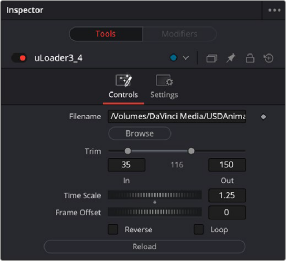< Previous | Contents | Next >
Manual Disk Caching Using Loader and Saver Nodes
The Loader and Saver nodes in the Fusion page are also useful for optimizing extremely complex and processor-intensive compositions. For example, you can render out specific branches of a node tree that no longer require frequent adjustment to OpenEXR via a Saver node, then reimport the result to take the place of the original branch of nodes in order to improve the performance of your composition. Used this way, Loader and Saver nodes provide a bulletproof manual workflow for caching using media files that will never be automatically purged unless you specifically delete them. As long as you retain the original branch of nodes, you can always readjust and re-render these manually cached parts of a composition, if necessary.
Importing Universal Scene Descriptor (USD) Files
The Universal Scene Descriptor USD framework is a set of open standards for describing, composing, and simulating a 3D environment. The USD file format is more than just a simple format - it’s an open source 3D scene description used for creating and sharing 3D content across various applications.
DaVinci Resolve and Fusion can import USD (.usdc, .usdz, and .usda) 3D information including geometry, lighting, cameras, materials, and animation. A new collection of USD tools has been added to Fusion, allowing users to manipulate, re-light, and render these USD files.
The USD Loader
![]()
The USD Loader allows you to import USD files and adjust its options.

The uLoader node
1 Add a uLoader tool to your Fusion Composition.
2 Select the USD file you want to load in the File Browser. If you wish to change this file in the future, you can do so in the uLoader Inspector without disrupting your node tree.